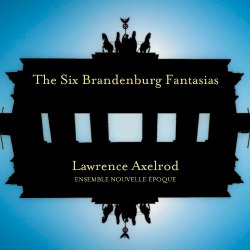|

|
Lawrence AXELROD (b.1960)
The Six Brandenburg Fantasias
Brandenburg Fantasia no.1, for three violins, three violas, three cellos and double bass [7:18]
Brandenburg Fantasia no.2, for flute, violin, harpsichord and strings [10:35]
Brandenburg Fantasia no.3, for three oboes, bassoon, 2 French horns and strings [7:40]
Brandenburg Fantasia no.4, for two flutes, violin and strings [6:06]
Brandenburg Fantasia no.5, for two violas, two violas da gamba, cello and double bass [13:02]
Brandenburg Fantasia no.6, for flute, oboe, trumpet, violin and strings [11:31]
Ensemble Nouvelle Epoque/Lawrence Axelrod
rec. no information provided.
INNOVA 876 [56:11]
Lawrence 'Larry' Axelrod's Brandenburg Fantasias constitute a cunning marketing ploy. Their title links them immediately in the music-lover's mind with Johann Sebastian Bach's famous Concerts à Plusieurs Instruments. However, a random dip into the content of this new release from the ever-innovative Innova label quickly disabuses the listener of any transpicuous connection with the master from Eisenach. Not only are these works not pastiches but Axelrod's music does not even seem to allude to Bach's. Length, character, texture, even numbering - almost everything that could be different, is different. Indeed, Fantasia no.4 is subtitled 'in tempore belli', written in despairing response to the Iraq War in 2003.
There are, in fact, bits and pieces of fugue form here and passacaglia form there that briefly, vaguely, remind the listener of ancient origins. That said, it is rather the sheer inventiveness of the orchestration of the original 'Brandenburg' Concertos that inspired Axelrod to compose what he calls "companion pieces" to them.
In fact, Axelrod has made some minor adjustments to Bach's instrumentation, as anyone familiar with the originals can see at a glance. Nor do the very impressive Ensemble Nouvelle Epoque use period instruments - underlining the fact that this is thoroughly modern music. Yet it is not avant-gardist: despite the aleatory episodes, jagged harmonies and occasional modernist gestures, the music is basically tonal and often reasonably melodic. Axelrod in any case achieves his goal of developing the possibilities inherent in Bach's instrumental challenges to come up with a colourfully orchestrated cycle that does not contain a dull moment. Certainly, the sequence is unlikely to appeal to those whose tastes centre on Bach. However, it remains easily approachable to audiences attuned to Axelrod's contemporaries like Jennifer Higdon, Ned Rorem and Richard Danielpour. The composer's own booklet notes take the listener through the objectification of his fruitful ideas.
Audio quality is generally very good, if somewhat 'enclosed' - the effect is not unlike a well-re-mastered analogue recording from the 1970s. Unfortunately no dates or venues are provided in the booklet.
Byzantion
Contact at artmusicreviews.co.uk
 |
 |
|
